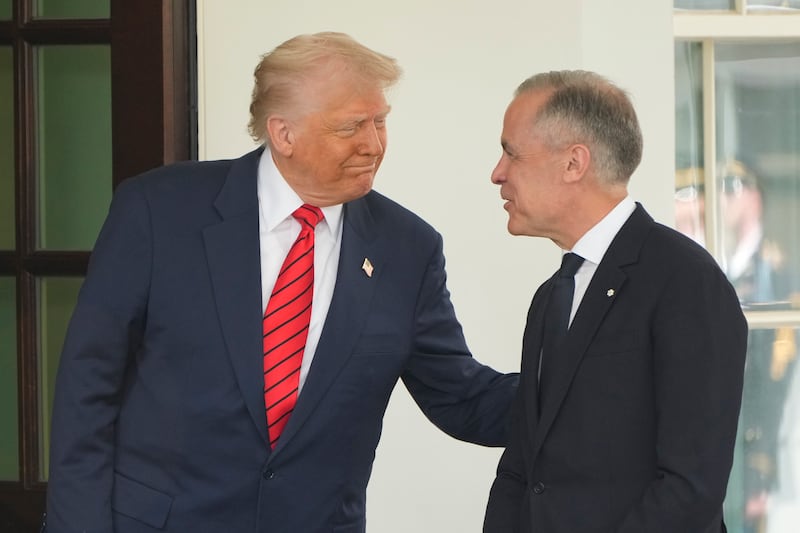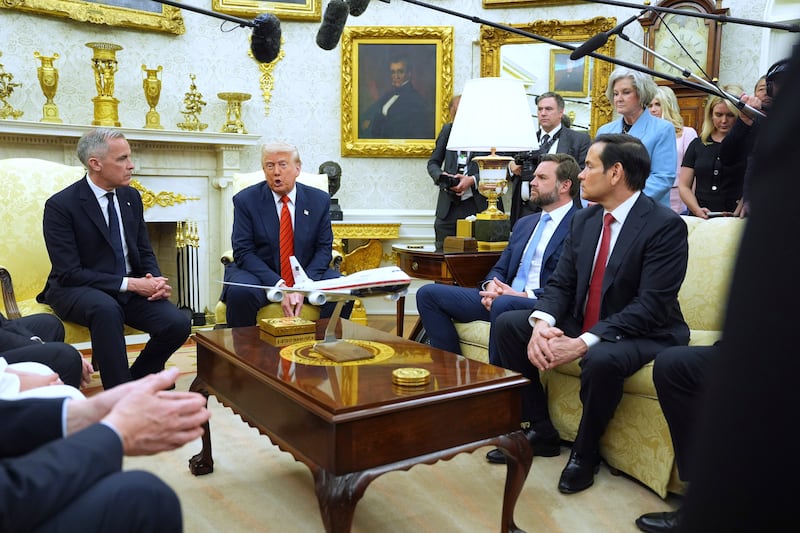President Donald Trump met his Canadian counterpart, freshly elected Prime Minister Mark Carney, in what turned out to be a delicate dance between the two in a White House Oval Office meeting on Tuesday.
The U.S. president wanted to avoid another heated meeting, like the one he had with Ukrainian President Volodymyr Zelenskyy in late February.
“We had another little blow up with someone else,” Trump said. “This is a very friendly conversation.”
His tone with Carney was also a stark contrast from the way Trump spoke to and about former Canadian Prime Minister Justin Trudeau.
“Canada chose a very talented person, a very good person,” Trump said about Carney before launching into his “love” for Canada.
“I’m on the edge of my seat,” Carney said with a laugh and thanked Trump for his hospitality. He admitted he shared the same goals as the U.S. president, like a focus on “the economy, securing our borders again, fentanyl, (and a) much greater focus on dependency security.” Carney patted Trump on the back for being a “transformational president.”
Still, amid the jokes, the flattery and their common ambitions for North America, Trump tested the waters for their expected negotiations and U.S. expansion to Canada while Carney drew a few lines in the sand.
The tension was evident underneath the pleasantries, stemming from the White House’s slew of tariffs directed at allies like Canada, which faces a 25% tariff on goods coming across the border, including steel. Canada imposed a reciprocal 25% tariff on American goods.
The meeting is a critical moment for Carney. Elected on April 28, Carney ran on the promise of forging a path forward with the U.S. — and Tuesday’s meeting shows that won’t be an easy task.

Trump responds to idea of removing tariffs on Canada
When asked what he hopes the top concession from Canada would be, Trump said “friendship.”
Trump said he isn’t inclined to do away with tariffs on Canadian goods as he seeks to spark an American “manufacturing renaissance.”
“We want to make our own cars,” Trump said. “We don’t really want cars from Canada, and we put tariffs on cars from Canada, and at a certain point it won’t make economic sense for Canada to build those cars. And we don’t want steel from Canada because we’re making our own steel.”
Trump also says he holds his northern ally partially responsible for the fentanyl and migrant crisis in the U.S.
This is despite the Drug Enforcement Administration’s Intelligence report pointing to Mexico and China as the parties largely responsible for the inflow of fentanyl, with India also emerging as a source. As for the unprecedented inflow of migrants into the U.S. during the Biden administration, it mostly stemmed from the southern border, according to the U.S. Customs and Border Protection.
But most importantly, Trump said, he wants the relationship between the two allies to be fair, and he believes it currently isn’t.
“There’s no reason for us to be subsidizing Canada,” the U.S. president said.
One reporter asked; Is there anything the prime minister could do to convince Trump to lift the tariffs? “No,” the president responded.
Could Canada become the 51st state?
Trump has also repeatedly said Canada should become the 51st U.S. state, and although he tauntingly called former Prime Minister Justin Trudeau “governor ... of the Great State of Canada,” he hasn’t leveled the same insults at Carney.
Carney, who hardly got a word in as Trump answered reporters’ questions rapid-fire style, sternly pushed back.

“Respectfully, Canadians’ view on this is not going to change,” he said.
Still, Trump continued making his jabs about erasing the border between the two countries.
“I’m a real estate developer at heart, when you get rid of that artificially drawn line, somebody drew that line many years ago, like a ruler, just a straight line right across the top of the country, when you look at that beautiful formation, when it’s together. I’m a very artistic person, but when I looked at that, you know, I said, that’s the way it was meant to be,” Trump said.
Carney countered that Trump must know that some places in real estate aren’t for sale.
“We’re sitting in one right now,” he added. “Having met with the owners of Canada over the course of the campaign last several months, it’s not for sale.”
Trump replied, “Never say never.”
Carney said he isn’t interested in such a marriage but more so in economic and military partnership. He offered Trump a small concession: “My government is committed (to) a step change in our investment in Canadian security and our partnership.” That includes Ottawa pulling its “full weight in NATO.”
Trump says U.S. is subsidizing Canada, Carney says U.S. is after Canadian resources
Trump’s position has caused cracks in the historic alliance between the two neighbors. Carney recently said his country has to forge a new path forward.
“There is no going back. We in Canada will have to build a new relationship with the United States,” he said last month.
He took over as prime minister after Trudeau’s resignation on March 14 and won the election more than a month later.
Carney slammed Trump in his election victory speech, painting the U.S. as overly ambitious and borderline greedy and giving Trump’s threats new life.
“America wants our land, our resources, our water, our country. But these are not idle threats. President Trump is trying to break us so that America can own us,” Carney said. “That will never ever happen.”
Ahead of the visit, Trump wrote in a post on Truth Social he looked forward to meeting Carney.
But the U.S. president claimed the U.S. is subsidizing Canada.
“I very much want to work with him, but cannot understand one simple TRUTH — Why is America subsidizing Canada by $200 Billion Dollars a year, in addition to giving them FREE Military Protection, and many other things?” he wrote.
“We don’t need their Cars, we don’t need their Energy, we don’t need their Lumber, we don’t need ANYTHING they have, other than their friendship, which hopefully we will always maintain. They, on the other hand, need EVERYTHING from us!”
Trump promised to ask Carney this very same question.
Future of free trade between U.S., Mexico and Canada
The talk of tariffs comes ahead of the United States-Mexico-Canada Agreement, or USMCA, renegotiations next year.
During the first Trump administration, this agreement replaced the North American Free Trade Agreement, or NAFTA.
Trump said he doesn’t think USMCA is “necessary anymore,” but it served its purpose, which was to get rid of NAFTA.
USMCA reformed the trade agreement completely, by strengthening labor laws, bolstering U.S. manufacturing and expanding American dairy farmers’ access to the Canadian markets, among many other measures, according to CNN.
Carney sees the USMCA renegotiations as a “basis for a broader” discussion.
“Part of the way you’ve conducted these tariffs has taken advantage of existing aspects of USMCA, so it’s going to have to change,” he stated.
Canada-U.S. trade was roughly $762 billion last year, according to the U.S. trade representative’s office.
It’s not only the largest trading partner of the U.S., the two countries also share an intertwined auto industry.
“You know, 50% of a car that comes from Canada is American. That’s not like anywhere else in the world,” Carney said. This is just one example of the interwoven partnership between the two countries and it “will take some time and some discussions” to finalize any negotiations.
Trump wants the media to stop asking about tariff deals
Trump said he views the U.S. as a “super luxury store”; “You’re going to come and you’re going to pay a price.” It’s up to the rest of the world to make compromises and “pay for the privilege” of being able to continue shopping, he said.
He expressed his frustrations with the media for questioning the deals struck amid the tariff negotiations so far.
“We don’t have to sign deals. We could sign 25 deals right now,” he said.
Trump said he planned to sit down with his Cabinet and write down his demands for each country. If the negotiating terms aren’t what the foreign country was looking for, the Trump White House is willing to go back to the drawing board, Trump said, defending it as being “flexible,” not “chaotic.”
India, for example, levies some of the highest import duties in the world — 27% — and Trump said his administration wasn’t willing to put up with that.
“They’ve agreed already to drop it,” he said. “They would have never done that for anybody else but me.” China, too, wants to meet for trade talks while their country takes an economic setback, thanks to the U.S., the president said.
“I wish they’d keep stop asking, ‘How many deals are you signing this week?’ Because one day we’ll come and we’ll give you 100 deals,” Trump said.


